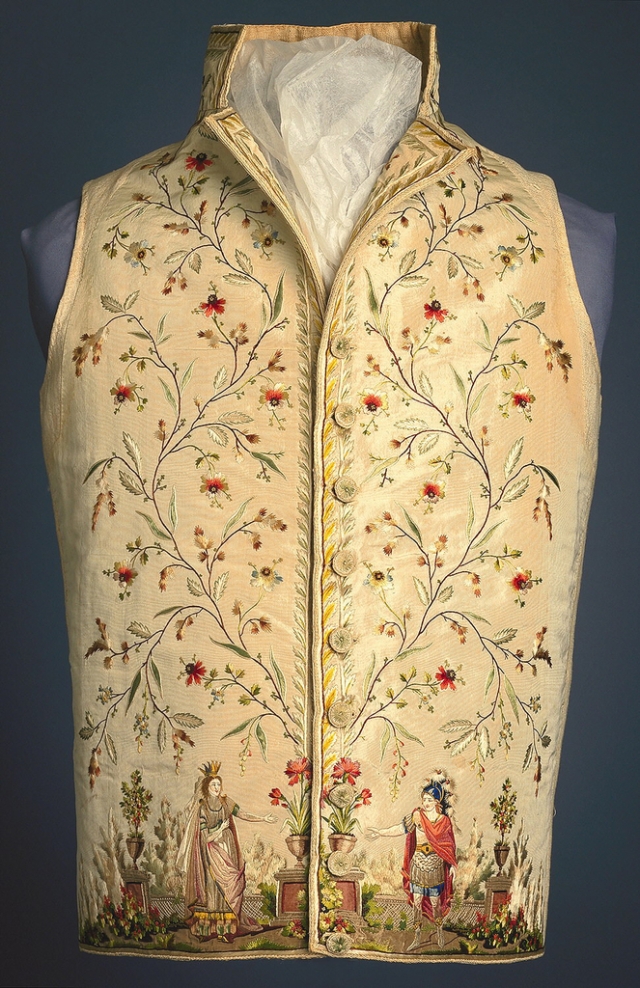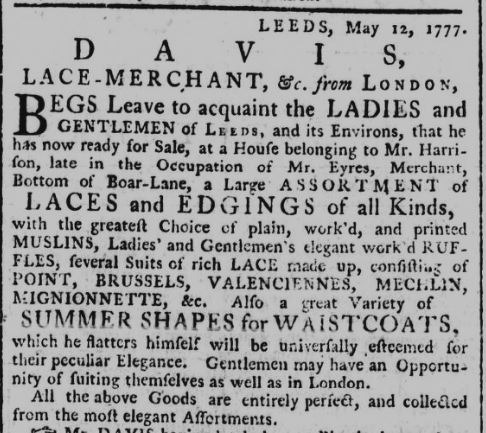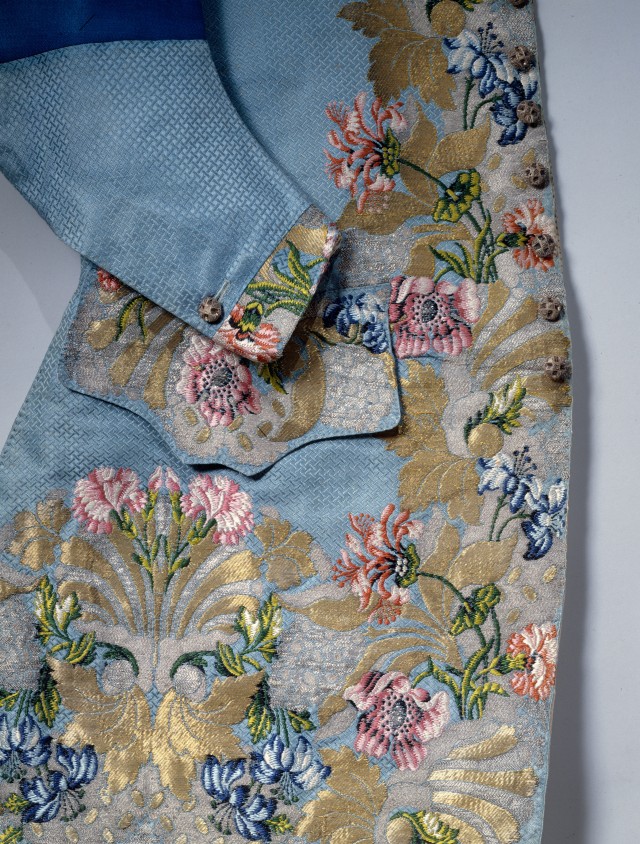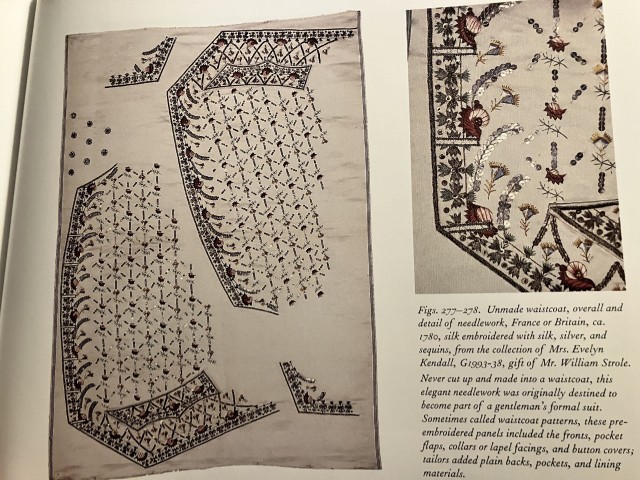In the 18th and early 19th century it was very much the fashion for men to wear some stunning waistcoats, so today we’re going to take a pictorial look at some stunning waistcoats from a variety of museums and galleries. Why don’t we see anything quite like these today? Perhaps time for a revival, maybe!

The first items is truly stunning especially when you look at the detail of the bottom of it. I can’t imagine how long that must have taken to sew.
I thought it was worth also taking a look at newspaper adverts to see who was actually selling waistcoats and how much they cost. Whilst there are plenty of adverts, none of them tell us how much such lovely items would have cost.





The design of this piece was created by Anna Maria Garthwaite, known for creating vivid floral designs for silk fabrics hand-woven in Spitalfields, London, in the mid-18th century.
Peter Lekeux was one of the many weavers working in Spitalfields, London, who died in 1768. In his will he left bequests to his wife, Mary, his mother, Sarah and his sister, Mary Margaret.
To finish, look closely at the pockets on this one, such intricate detail

Following on from a conversation with Jennifer Newbold, please see below a fine example of a waistcoat pattern.



Wow, the embroidery on the waistcoats is really beautiful! It must have been big business to be an embroiderer back then. I wonder if the patterns were already made or the customer had the pattern made to order.
I find the wolf and the crane waistcoat particularly fascinating. But let’s not forget the moral of the story: Don’t expect any reward or gratitude from someone who is not honourable; you will be disappointed. The poor old crane got his kindness thrown right back in his face.
LikeLiked by 1 person
They are stunning and would probably cost fortune to make today with all that beautiful hand stitching. I would have thought, as today, there would be off the shelf patterns, but I do suspect more were bespoke back then – costing more, of course 🙂
LikeLiked by 1 person
it’s stunning! the embroidery looks very intricate and sophisticated. I wonder if they use real gold thread for the embroidery.
LikeLiked by 1 person
They’re all beautiful but sadly, I’ve no idea whether they used real gold thread.
LikeLiked by 1 person
as an embroideress until my sight deteriorated, i’ve looked into the history of embroidery threads. the most expensive threads were gold foil over a silk core, and this led later to the fashionable passtime of ‘drizzling’ or unravelling scraps of fabric. Prince Leopold is said to have spent all his time after Princess Charlotte died with his drizzling box. there were tools made for it. it was often practised as part of a vocation as well by rag and bone men’s wives to get out any precious metal in fabrics, to melt and sell. You had to drizzle a lot to make much money though.
cheaper threads would be covered with pinchbeck not gold. Likewise with the bullion on uniform coats; impoverished young sailing officers particularly had to put up with their epaulets turning green in the tropics.
Judging by the still fine, bright gold in these, it’s real gold.
LikeLiked by 1 person
Peter Le Keux is my 1st cousin 7x removed. I love his work!
On another note, in 1969, my parents were clearing out an old Irish house, the back part of which was probably dating from mid- late 1600s. In the press (airing cupboard) my mother found a bundle of old materials, so she rolled them up in another large, dirty piece of material and used it to bring down books etc from the 3rd floor. They brought it back to England, where my mother threw it in the washing machine, thinking it would have some use as dusters perhaps.
When it came out of the washing machine, she found it was an old patchwork bedspread!
Sometime later, she took some stuff to the V&A. The man was thrilled with the patchwork bedspread, saying that it was made with off-cuts from the first imported Indian cotton made to line gentlemen’s waistcoats from the reign of Charles II or possibly James II!!
ONE of the pieces of patchwork had rotted, but the rest were OK, presumably because they had been kept in the dark for 100s of years
Unfortunately, it was sold by my parents.
LikeLike
As I’ve often said, Sylvia – you really do have some amazing ancestors 🙂
Oh wow, that’s quite a story, I wonder who they sold it to – hopefully a museum so that everyone can enjoy it, but I suspect not.
LikeLike
In previous centuries, cloth from high-fashion clothes was often recycled into other items, such as cushion covers, once the clothing grew old or fell out of style. It was expensive, after all. Even royalty recycled or gave away their clothes. The most famous example is an altar cloth that is thought to have been made from Elizabeth I’s dress in the Rainbow Portrait.
LikeLiked by 1 person
They were much better at recycling than we are today, I think 🙂
LikeLiked by 1 person
Yes, in previous centuries, everything got recycled, even dog poo (collected and used in the tanning process), and it was a common way for people in dire poverty to make ends meet.
LikeLiked by 2 people
That’s the origin of the phrase “Hand-me-down”
When clothes were sold in the street markets, they would be hung up out of people’s reach, so a potential buyer would ask the seller “Hand-me-down the blue dress”
LikeLiked by 1 person
Somewhere I have a baby’s bonnet made by my great gran when she was in service as a nursery maid, from an old embroidered waistcoat she was given by her employer in case she could get any use of it.
LikeLiked by 1 person
Aww, how lovely 🙂
LikeLiked by 1 person
Also clothes were given away in wills.
LikeLike
Yes, absolutely, I’ve read that in so many wills with a lot of wealthy people’s clothes going to their servants too.
LikeLiked by 1 person
I suspect the embroideresses were paid a pittance on piece work per pair of shapes and, if included, pocket flaps.
LikeLike
I’m pretty sure you’re correct, Sarah!
LikeLike
Such stunning designs, they must have taken hours of meticulous work. Definitely made just for the very wealthy.
LikeLike
Agreed, not something most of us could have afforded to buy, that’s for sure 🙂
LikeLiked by 1 person
Here is a photo of a ‘waistcoat pattern’ that was never made into a waistcoat. Now, I would imagine that some waistcoats, particularly the most intricate ones, were bespoke, but apparently not all of them were!

From What Clothes Reveal, by Linda Baumgarten, The Colonial Williamsburg Collection The Colonial Williamsburg Foundation/ Yale University Press, New Haven and London, 2011
>
LikeLike
Thanks Jennifer, sadly images don’t seem to appear in comments, but if you’d like to email it to me I can add it to the post for readers to view 🙂
LikeLiked by 1 person
Many thanks, Jennifer for sending me that image, I’ve added it to the post 🙂
LikeLike
Thanks Jennifer ( and Sarah!) What wonderful work! I love the buttons !
I wonder why it was never made up? Perhaps the tailor didn’t have any mice to help him!!!(Beatrix Potter, The Tailor of Gloucester)
LikeLiked by 1 person
The best waistcoat patterns ( known as ‘shapes’) were woven and embroidered in France – particularly Lyon – and imported. Once the vest had been made up, further embroidery (e.g., over the seams) could be added.
LikeLiked by 1 person
In the centuries before industrialisation, cheap and ready third world labour (sorry), synthetic dyes, washing machines and sewing machines, clothes were not cheap when cloth had to be imported, clothes sewn by hand, dyes made by natural means, with some colours extremely hard and expensive to obtain, no synthetic materials, and all washing done by hand. No wonder clothes had to last, be recycled in every way possible, or be worn for as long as possible, even if they were past their best.
LikeLiked by 1 person
Pingback: Loyalist Trails 2023-06 – UELAC
Reblogged this on sketchuniverse and commented:
🎩 HELLO SISTERS! LET’S GIVE A CHANCE FOR GENTLEMEN ART.
LikeLike
Pingback: Loyalist Trails 2023-29 – UELAC